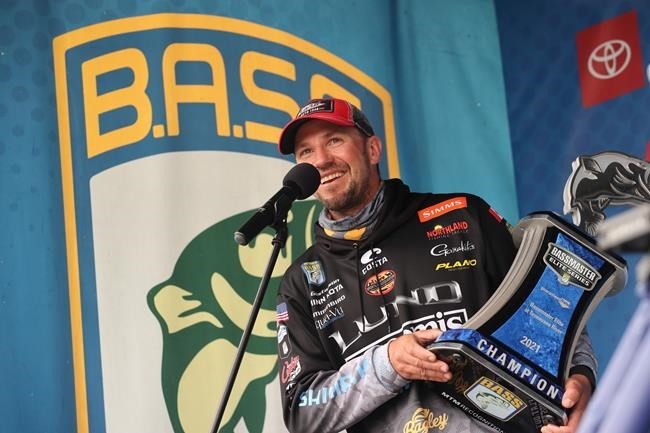He's already a marked man but technology will present Canadian Jeff Gustafson with a formidable challenge this season.
Last year, the Kenora, Ont., angler became the first Canadian to capture the US$1-million Bassmaster Classic — pro bass fishing's premier event — on the Tennessee River. But many Elite Series competitors this season will have significantly beefed-up electronics on their boats, running anywhere from three to six forward-facing sonar units.
Forward-facing sonar — notably Garmin's Livescope — has taken the fishing world by storm. Currently, there are no rules regarding how many units Elite Series anglers can use.
Anglers can see if bait is present and whether fish are nearby, if fish are suspended or relating to structure and where. All the while knowing exactly how far they are from the boat.
Fishermen can't pinpoint exactly what species they're seeing but with experience can have a pretty good idea. By watching a screen, they can see what depth their baits are running at, how close the presentations are to fish, their reactions and if/when they strike, all in real time.
Gustafson won the Classic with just one forward-facing unit. He'll have two Thursday when the Elite Series — pro bass fishing's top circuit — opens 2024 at Toledo Bend Reservoir on the Texas-Louisiana border.
"I just felt like I didn't have a choice," Gustafson said. "It's crazy how much (technology) has changed the landscape of tournament fishing in the last two years.
"If you're not utilizing it at most of these places we're going to, you're going to get left behind and I realize and see that."
Gustafson used forward-facing sonar to locate smallmouth bass during the Classic, then suspended a four-inch smelt-coloured plastic shad on a 3/8-ounce jighead above bottom-hugging fish. The technique, called moping, secured Gustafson 12 smallmouths for a tournament-winning 42 pounds, seven ounces.
He implemented the same approach two years earlier on the Tennessee River, again going wire-to-wire for his Elite Series victory.
With only three days of practice, the technology helps maximizes time on the water heading into a tournament. Elite Series winners earn US$100,000 while the Classic champion pockets $300,000.
Canadian brothers Cory and Chris Johnston, of Cavan and Peterborough, Ont., respectively, both have four units on their boats this year. Sophomore Cooper Gallant, from Bowmanville, Ont., went from one last year to three currently, like Gustafson, figuring he must in order to remain competitive.
"It (forward-facing sonar) has definitely simplified things but at the end of the day you still have to catch them," Gallant said. "But they've saved us a lot of time because you can just put the trolling motor down and see if they're there or not, you're not wasting 10-20 minutes trying to catch one."
But the technology isn't cheap. Adding four transducers and graphs alone could total nearly $20,000, excluding the cost of batteries and charging units required to run all of the electronics.
That's not an issue for pros with Garmin sponsorship deals. Others, though, must weigh the cost of paying out of pocket for units versus the possibility of cashing more cheques with them.
Ditto for guides, whose livelihood depends on consistently putting clients on fish.
But when recreational anglers or those participating in local tournaments see professionals using multiple units, many could feel that's what they need to be successful.
"The reality is do you need this stuff to go catch a few fish?" Gustafson said. "No, but it certainly helps.
"If you really want to do it competitively, it's pretty hard to compete without it, at least on many fisheries."
Gallant said forward-facing sonar is an important tool in tournaments but doesn't believe anglers need multiple units to compete.
"But if you want to compete, you definitely need one and can definitely compete using just one," he said. "I mean, 80 per cent of the (Elite Series) field the last four, five years has only used one."
Gustafson wishes forward-facing sonar had never hit the market.
"It's fun, you learn a lot from it and I'm never going to say we must ban it but I don't love it," he said. "I think it does take a little bit away, for me, from the million hours I've spent in my boat learning how to fish, how fish behave and a lot of that stuff.
"It's changed things. It has really levelled the playing field at many of these places we go. It has definitely made it easier for people to show up somewhere and be able to find fish much faster than in the past."
This report by The Canadian Press was first published Feb. 20, 2024.
Dan Ralph, The Canadian Press




